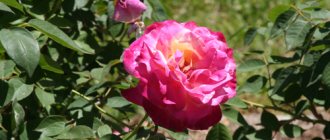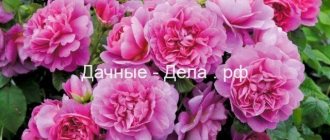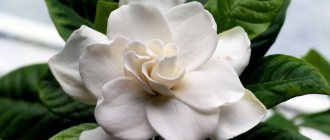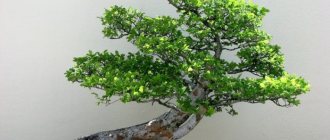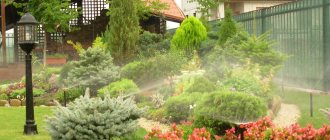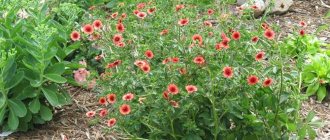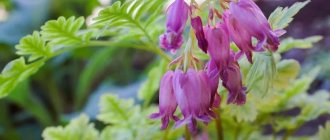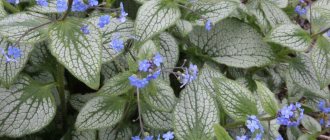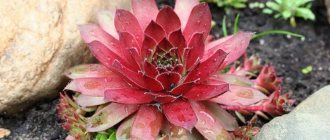Each of us dreams of surrounding ourselves with comfort, adding aesthetics and beauty to our days. Those who have summer cottages are increasingly wondering how exactly to decorate their territory. This is where landscape design comes to the rescue. It makes it possible to make your garden cozy, harmonious and individual. For flower lovers, perhaps the best thing would be to use a perennial plant such as garden begonia in your project.
Garden begonia is ideal for decorating flower beds and borders in a country area
Which begonia variety to choose for the garden?
Begonia - common in the form of vines, subshrubs and shrubs. Mainly 3 types are used for gardening.
Each variety of begonia is beautiful in its own way
Tuberous
Tuberous begonia is a low plant, reaching 30 cm in height. In diameter from 5 to 22 cm. Fruits in winged capsules. The flowers are dioecious, that is, both male and female flowers are present on the same plant. The most common varieties are: Golden Ball, Orange and Cupferorange.
Tuberous begonia decorates summer cottages from June to September, and blooms in closed greenhouses until late autumn
Tuberous begonias have many subspecies, and they are all very different from each other. These varieties grow best in pots or special containers, which make it easier to ensure proper watering. They may die in open ground. They do not like abundant watering and direct sunlight.
Ampelnaya
Begonia ampelous - belongs to the subspecies of tuberous begonia. It is also called pendulous. The shoots are long and dotted with flowers at the top. They have beautiful glossy leaves and are usually grown as houseplants. But they also do well in the shade outside, living in any pots.
The shoots of ampelous begonia can grow up to 80 cm, and the flowers retain their decorative effect until light frosts.
Everblooming
Begonia everblooming - presented in the form of small bushes with green foliage and a riot of flowers. The height does not exceed 15 cm. The most popular: Firemeer and Olomouc. Ever-blooming begonia is easy to care for. Blooms from spring to autumn, and is easy to grow in pots and garden beds. When planted densely, it provides an abundance of flowers.
Different varieties of ever-flowering begonia differ in color, leaf size and flowering period
There is also a hybrid ever-blooming begonia. This is an ordinary begonia, but several times larger. In America they are also called the 50 mph plant. Because they create an incredibly captivating appearance when viewed from a car at this speed. The hybrid variety can grow between 50-90 cm in height.
Begonias look good in company with other ornamental plants
Dwarf coniferous plants, cereals, hostas, and cineraria coexist perfectly next to begonias.
In the past, begonia color choices were usually limited to green or bronze foliage with white, pink or red flowers.
Reproduction
Your favorite variety can be easily propagated by cuttings. Usually cuttings are carried out in the spring, when the plant begins to grow.
Begonia cuttings
The cutting process is step by step:
- Take a stationery knife or scissors, treat the blades with alcohol and cut off a part of a branch at least 10 cm long with 2-3 internodes. The cut is made obliquely under the internode.
- The lower leaves are torn off.
- Leave the cuttings in a dry place for an hour to dry the cut.
- Small containers, it is more convenient to take plastic cups, are filled with soil for begonias. You can add perlite to the soil. Lightly moisturize.
- We make a depression in the substrate and place the cutting there, squeezing it on the sides with our fingers.
- Cover the top with film so that it does not come into contact with the cuttings.
- Place in a warm (+22… +24 degrees), bright place without scorching sunlight (preferably under phyto lamps).
- We ventilate the cuttings every two days.
- We water as the soil dries in very small portions.
- In about a month, the begonias will sprout roots, you will notice this by the appearance of new leaves on the cuttings. When the roots grow, transplant the cuttings into small pots and remove the film.
Now you have several new plants from one bush.
The main thing now is to ensure that no pests or diseases appear on them.
Remember! Begonia is most afraid of overwatering
Begonia ever-blooming. Reproduction
How to grow garden begonia: planting and care
With the onset of warm weather, they begin to plant the plant in its permanent place. You need to make sure that there will be no more frost. Tuberous begonias are planted when the plant has produced flowers; before that they are kept in greenhouses.
Before planting, the tubers must be cleaned of rotten sprouts and treated in a weak solution of potassium permanganate
Begonia everflowering is planted with seeds through seedlings
For rich and healthy flowering, you need soil saturated with minerals and trace elements with an acidic reaction.
Watering should be moderate during the flowering period and abundant during the growing season. Also, do not forget that during the growth period it is necessary to feed the plant:
- To help increase the green mass in the spring, use the entire complex of fertilizers. They can be purchased at any gardening store. That’s what it says on the packages – fertilizers for begonias.
- When the plant produces buds, phosphorus and potassium fertilizers, as well as microelements, should be given.
Begonia does not like crowding, although it creates a continuous cover. When planting, each plant should be located at a distance of 30 cm from each other. The flower itself is perennial, but in our conditions it usually does not survive wintering, so a new planting is required the next year.
Planted begonia seedlings in a garden bed
The best place for it will be a semi-dark area in the garden. Does not tolerate standing water. Prefers rich acidic soil. You can help begonias overwinter by using a dense layer of mulch around the root system.
It is best to water begonia in the morning, before the heat sets in.
To protect begonias from pests such as greenhouse aphids, scale insects, whiteflies, thrips and nematodes, it is necessary to resort to the help of drugs, the dosage of which is indicated by the manufacturer on the packaging. Most infections occur in greenhouses.
Spider mites on begonia Powdery mildew on begonia
Nematode on begonia
Begonia can also suffer due to improper care: too much watering, poor feeding and the wrong site for planting it. Begonia flowers planting and care in the garden.
Inexperienced gardeners should refrain from planting the plant in open ground, as it is not frost-resistant.
Many gardeners grow begonia at home in containers and take it out into the garden only in the summer.
Groups
Begonia is a perennial or annual herbaceous plant. It grows in a variety of ways: in the form of creeping herbs, tall bushes, and subshrubs. So that experienced gardeners, and especially beginners, do not get confused, all types of begonia are divided into three conditional groups, each of which has its own distinctive features.
Tuberous
They are distinguished by large double flowers that bloom profusely on the bush. Also, this group of begonias has the longest flowering period. Tuberous plants can be grown both in tubs or flower beds, and at home. The bulbs of this group overwinter in an old pot or in the refrigerator, and after waking up they quickly resume the growing season.
Bush
They can be either annual or perennial. The former are more often used for outdoor and tub growing. At zero temperatures, the surface part of the bush dies, but it can resume growth if the ground is not frozen and the roots are preserved.
Decorative foliage
Bright, carved leaves distinguish this group from the rest. The most popular varieties are those with matte, “fluffy” leaves. These begonias reproduce by means of rooting or dividing leaves.
But, despite the division, all begonias have several common characteristics: the obligatory presence of unisexual flowers, a fleshy stem, asymmetrical leaves, and a powerful, thick rhizome.
Both gardeners and hobbyists sometimes confuse annual and perennial plants. To avoid confusion, we need to take a closer look at the types of begonia.
Beautiful photos with begonias
By looking on the Internet for examples and photos of begonia flowers in the garden, you can understand what exactly you would like to see in your design. Until the very first cold weather, flower beds with begonias will look great. With proper care and following all recommendations, you will get a high-quality result that will delight you.
Round flowerbed with terry begonias of various colors
This is roughly what an ideal design for a round flower bed using begonias looks like. Well-chosen flowers attract attention, but at the same time create an atmosphere of comfort.
Begonias in pots in front of the porch of a country house
A great example of how begonias can be used in pots. Showing your imagination, you can decorate a balcony, front door, path in the garden, gazebo or path to the house, choose flowers to match the decoration of the house or other plants in the garden.
Luxurious flower garden with begonias in combination with other plants
In this photo you can see how begonias can be used to decorate taller or rougher plants. In addition, this flower unobtrusively fills all the free space. Excess can be easily trimmed without harming the plant.
Begonias in containers on a brick porch
Here we see a simple, yet elegant and aesthetically pleasing example of a yard design. A brick covering with the same curb goes well with decorative plantings. It is not necessary to plant begonias along clearly defined lines. They will decorate any space in the garden.
What you need to start floriculture
To engage in floriculture you need: first, to want it, second, and most importantly, to love plants. I am sure that plants feel how they are treated. And if you don’t love cultivated plants, they won’t grow. Well, or it will be bad. Here are the weeds, they grow regardless of any love. The same applies to the experience of the florist. Until you gain experience and improve your skills, many things will not work out well for you. If, despite the first failures, you continue to grow plants with love, then the plants will begin to listen to you. Basic requirements for a flower garden: plants must be healthy, not overgrown, not block other flowers or interfere with each other. There should be no weeds among the flowers. The color scheme of the flower garden should be chosen with taste. Although there are many controversial issues here, and as you know, there are no comrades for taste and color. In general, a flower garden should always please the eye: either with flowers, or with bright colors of leaves, or with unusual plants.
Photo of begonia in the garden
Begonia flowers in a rustic flower pot.Watering
Our climate is difficult, sometimes too hot and dry, sometimes too cold and damp. This places restrictions on the species composition of flowers and requires careful attention to watering. There is drought for at least 2 weeks during the summer, and without watering, annuals will die or will have a completely different appearance than you expect. Most garden plants need to be watered abundantly, preferably in the evening or morning, before or after the sun shines. On a cloudy day - at any time. If you do not grow marsh plants, then water should not stagnate in the flower garden. Most flowers cannot tolerate this. That is, everything is good in moderation. And you must definitely study the requirements of the plant being planted.
Description and history of the appearance of the species
The ornamental plant has asymmetrical leaves of unusual color. The lower part of the leaf is reddish, brown and dark purple. The stem of begonia is erect with pronounced nodes or lodging. The inflorescences represent several small, medium or large flowers (complex panicle). Flowers are unisexual, monoecious, irregular.
Depending on the configuration of the bush and the size of the flower, tuberous begonia is:
- Large-flowered.
- Small-flowered.
- Ampelous (how to propagate ampelous begonia is described here, and how to care for this variety, read here).
The tepals are unequal and brightly colored. The fruit is a triangular shaped capsule. The history of the origin of tuberous begonia goes back to the mid-19th century.
Hybrids created from two varieties of wild begonia from Bolivia have appeared on sale (you can learn more about Bolivian begonia here). They were called Zeden.
Later, this species was used to cross begonias of different species: David, Clark, Veitchi. At least 7 types of crops were used to obtain modern varieties.
